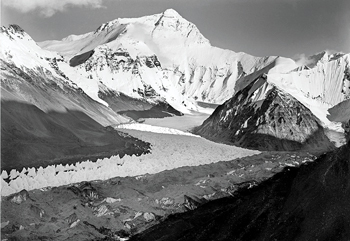What will the Himalaya look like in 100 years?
Five-time Everest summiteer and American filmmaker David Breashears helps raise awareness about the consequences of climate change in the Himalaya
Five-time Everest summiteer and American filmmaker David Breashears helps raise awareness about the consequences of climate change in the Himalaya using science, art, and adventure through his organisation, GlacierWorks. Nepali Times caught up with him recently to talk about the latest findings on how fast the mountains are melting.
Nepali Times: How did GlacierWorks start?
David Breashears: When I went to Everest as part of a documentary for the PBS series Frontline in 2007, I took along a black-and-white photograph taken in 1921 by George Mallory. It showed the ice-encrusted north face of Everest and below it the great river of ice known as the Main Rongbuk Glacier, flowing in a sweeping, S-shaped curve down a broad, stony valley.
I sat in the exact spot where Mallory had snapped this iconic picture and was stunned by the changes I saw in the landscape. The wide river of ice had retreated more than half a mile, leaving a field of separated ice pinnacles melting into the rocky ground. In the distance, the ice streams on Everest’s flank also had shrunk, exposing more of the mountain’s dark face. This was when I understood the actual magnitude of what climate change was doing to the mountains and I wanted to start a dialogue about what is happening in Himalaya.
I decided to use match photography to bear witness to the rapid warming of the Himalaya and the retreat of its glaciers. We have a collection of compelling and fascinating images, which come primarily from the extensive archive of the Royal Geographical Society in London. Using match photography, people can look at images from the past and present and ask questions: what happened, what led to these changes, and what will the future of the mountains look like?
How has climbing Everest changed over the years?
Those of us who have climbed Everest for the past 33 years have seen the changes taking place under our own feet. For instance, the Hillary Step at 8760m and the traverse to it from the South Summit were almost entirely snow climbs with very little exposed rock. Now our crampons scrape and scratch across hundreds of feet of exposed rock and the snow arête that Hillary climbed no longer exists. The route is entirely on rock and many feet to the left. We’re seeing the same changes as the glacier melts at 6500m: the garbage disposed in the glacier’s crevasses over 60 years is now being exposed because of glacial melt.
Is the Himalaya melting faster than we originally thought?
I’m not a scientist, but from my personal observation the changes in the landscape in some regions of the greater Himalaya are quite dramatic and in others they are harder to discern. This has to do with variations in precipitation and different weather patterns. For instance mountains in north-west Karakoram like K2 receive most of their snow in the winter from a westerly flow. That snow much more readily compacts into ice than regions in the eastern Himalaya, near Everest and Kangchenjunga, which receive their snowfall in the summer during the monsoon and when it’s much warmer. However, there needs to be much more ground research to better understand these transformations and what they mean for the future.

ROYAL GEOGRAPHICAL SOCIETY / GEORGE MALLORY
YESTERDAY AND TOMORROW: George Mallory’s iconic picture of the Rongbuk Glacier on the north side of Everest taken in 1921 (left) and David Breashears’ photograph taken in 2007 showing how much the glacier has shrunk. There has been even more melting in the last six years.

GLACIERWORKS
What can Nepalis do?
Nepal has an extremely tiny carbon footprint and contributes very little to greenhouse gases. However, there is much that can be done in terms of adaptation and creating policies and education initiatives to deal with the anticipated impacts of warming in this region.
What will your famous panorama photograph of Everest look like if it is shot 100 years from now from the same spot?
As you know earlier this month we surpassed 400 ppm of carbon dioxide in the atmosphere. If this global trend continues, there will be considerably less snow and ice on the mountain and the glacier will be in a much less stable state. But the truth is that we don’t know what it will look like in 100 years. We hope others will return to this spot, just like Norman Dyhrenfurth and I have done, and continue building a photographic record so that we will be better able to predict what the glacier will look like in the future.
www.glacierworks.org
Trailer of Storm over Everest directed by David Breashears